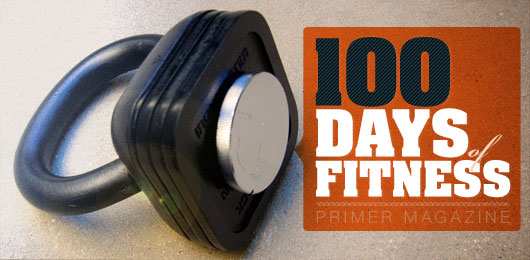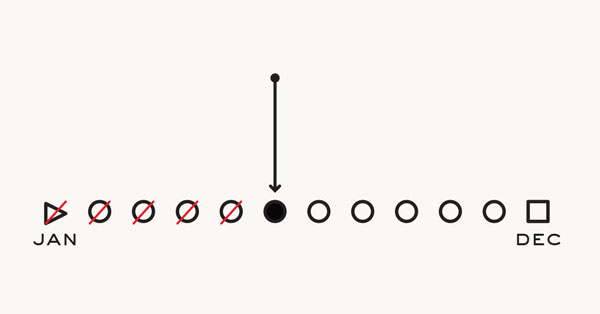100 Days of Fitness
- 100 Days of Fitness: An Introduction
- 100 Days of Fitness: Week 2 - Nutrition
- 100 Days of Fitness: Week 3 - Exercise
- 100 Days of Fitness: Week 4 - Building a Home Gym
- 100 Days of Fitness: Week 5 - Supplements
- 100 Days of Fitness: Week 6 - Expectations
- 100 Days of Fitness: Week 7 - Footwear
- 100 Days of Fitness: Week 8 - Food Lies
- 100 Days of Fitness: Week 9 - Meet the Kettlebell
- 100 Days of Fitness: Week 10 - Sample Circuits
- 100 Days of Fitness: Week 11 - Days vs Weeks
- 100 Days of Fitness: Week 12 – The Geography of Weight Loss
- 100 Days of Fitness: Week 13 - Travel Training
- 100 Days of Fitness: Week 14 – Meals, Snacks, & The Pocket Workout
- 100 Days of Fitness: Week 15 - What It's All About
- 100 Days of Fitness: Week 16 - Endless Push-Ups & Learning the Pull-Up
- 100 Days of Fitness: Week 17 – Adjustable Kettlebells + A Circuit
- 100 Days of Fitness: Week 18 – Intermittent Fasting & Strength Test
- 100 Days of Fitness: Week 19 – 15 Minute Workouts & A Cool Workout iPhone App + Contest
- 100 Days of Fitness: Week 20 - Switching It Up
- 100 Days of Fitness: Week 21 – Reflections
- 100 Days of Fitness: Week 22 – A Week Without a Workout
- 100 Days of Fitness: Week 23 – Why We Work Out & The 30 lbs Lost Marker
- 100 Days of Fitness: Week 24 - 5 Common Home Gym Mistakes
- 100 Days of Fitness: Week 25 – Work Ethic
- 100 Days of Fitness Special: Men's Health in Movember
- 100 Days of Fitness: The Muscle Aesthetic
- 100 Days of Fitness: The Cure for Holiday Pounds
I've already talked about the benefits of kettlebell training and sung their praises. They're an excellent tool that can help you rock out a full body workout, or can be used to target specific body parts with isolation moves. The downsides, however, are cost and weight. Kettlebells are heavy – hey, they're supposed to be – so just one weight generally doesn't work for most people to do lots of exercises. If you're strong, a 24kg kettlebell can be used for almost any exercise. If you're just getting started, it's most assuredly too heavy for isolation exercises, though maybe right for full body work. But even then, soon you might need to go up a level – and that's costly.
You see the dilemma here. One kettlebell doesn't cut it for most people – and when you have to start small, you outgrow them fairly quickly.
Luckily, there is a solution: the adjustable kettlebell. There are several models out there at varying levels of cost. One brand that caught my attention was the IronMaster Quick-Lock Adjustable Kettlebell. The reason I went for this method was two-fold. First, it can get heavy. Fully loaded with plates, this model can reach 57.5lbs, which is 5 lbs more than a standard 24kg bell. Second was price – fully loaded, the IronMaster KB costs about $158. Now, this might seem expensive, but when you compare it to other kettlebells, it's a great deal.
For a solid, standard bell, you're going to pay more than a dollar a pound. A 55lb bell normally costs around $80. Other adjustable kettlebells cost around $115 but only go up to 40lbs. So for under $160, you get one system that can go from the light-end of 22.5lbs all the way up to 57.5lbs. In between those two extremes, there are 6 other weights, meaning you basically now have 8 kettlebells in one system. Nice.
The system works by having a handle unit (that weighs 22.5lbs, a perfect weight to practice with), a quick-lock screw, and 7 plates of different weights. To change the weight, all you do is remove the screw, add some plates, and tighten it back up. Switching plates is easy and, once tightened, the system is secure. I've tossed it around without incident.
The feel is slightly different from a normal kettlebell. The handle is a much bigger loop, which some may prefer, and the shape is less like a ball, but still comfortable to use. When it comes to a consideration of cost and versatility, I don't think there is any better value than the IronMaster kettlebell. Not to sound like a shill, but you're getting virtually 8 different kettlebells for $160. Compare that to basically every adjustable system out there and it's up to $300 less than most adjustable dumbbells.
So if one big kettlebell doesn't work for you, consider an adjustable bell.
Now that there are no excuses for not buying one, here's one of my harshest kettlebell circuits.
Perform the entire circuit 2-3 times. While in the midst of a circuit, attempt to complete it as fast as possible with as little rest between exercises as possible. No rest is preferable until each circuit is complete. Every exercise is completed with a kettlebell. (Check out my previous article for a run-through of each exercise.)
- 10 Snatches each arm
- 10 one-arm kettlebell swings each arm
- 10 floor presses each arm leading into 2 Turkish Get-Ups per side (Do 10 presses right side, followed by two right side get-ups, then repeat with the left arm)
- 12 single leg deadlifts each leg
- 12 two-arm kettlebell swings
- 10 hand-on-kettlebell pushups each arm
- 8 single arm bicep curls
- Water Break. Repeat.
I think you'll find that circuit to be a pretty hard kick in the pants, but intensity is good.
My Results
After a lackluster weak of complacency, I'm still at 229. Because I've been on the program so long, I find myself not marking down days on the calendar, but also allowing myself more “little breaks” than is good. Right around 230lbs has always been my sticking point in weight loss. It's time to get serious again and really try to blast through this plateau.
I still make the right choices 98% of the time which is allowing me to maintain weight without sacrifice, but to lose weight again, I have to get rededicated. The secret to long term success on any program is, even if you get a little lax, never give up. Acknowledge your problem areas and plateaus, rededicate, and blast through them. Don't stop till you reach your goal.

















